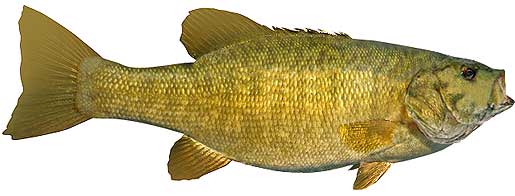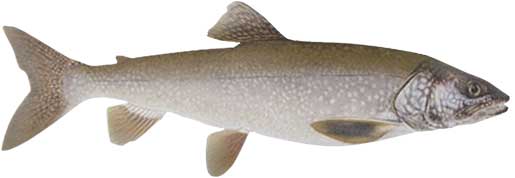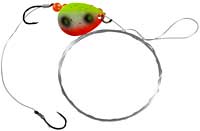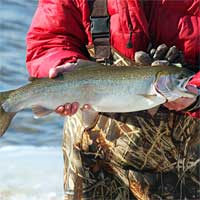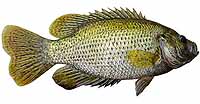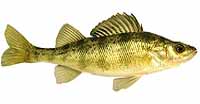Fishing Report For Torch Lake, MI
By Rick Seaman
Last updated on .
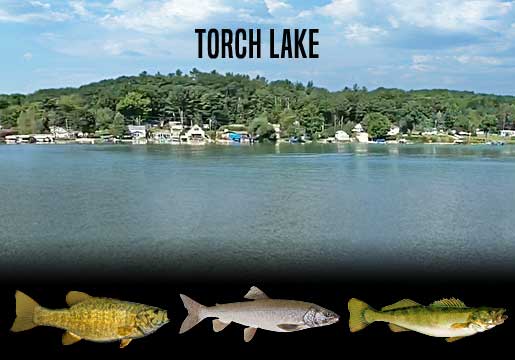
Fishing Reports
Popular Fish Species Torch Lake, MI
Smallmouth Bass
Current Report: Good To Very Good
Torch Lake offers quality smallmouth bass fishing, in the clear cool water smallies love.
FALL. As Fall arrives, smallmouth here follow schools of baitfish into coves and bays 6 to 18 feet deep. They thrive in the cold, clean water, which is an ideal environment for them. Locals report that tube jigs are a great choice when the bass are in 15' or shallower. Drop shot rigs with small worms or shad shaped plastics are also popular in 10' water or deeper. Jerkbaits, deep-diving crankbaits, and slow-rolled spinnerbaits, are also successful, when bass are shallow to mid depth. Later in Fall, smallies move to slightly deeper water, around 15 to 25 feet deep. Fishing shallow for smallmouth is often good on cold, windy, cloudy and rainy days.
WINTER. Winter will isolate them around deeper structure, points, flats and creek channels, often suspending in open water above these features. They can generally be found from 20 to 35 feet deep. Jigging spoons, tube baits, drop-shot worms, jigs and Ned rigs tend to temp smallmouth in deep water. I like to work these deeper haunts very slowly, as the bass are somewhat sluggish. Here they hold, feeding less frequently, awaiting warmer water to return in Spring.
SPRING. After ice out, when water temperatures rise into the 50's, smallmouth move from deep wintering spots to shallower water, just outside spawning areas. Tournament anglers report catching smallmouth when the bite turns off, by fishing small tube baits on light line. The first hour and the last hour of the day is a good time to find smallmouth feeding in very shallow water. Once the sun gets up, down go the bass to hang out on breaks in structure. They feed heavily in 3 to 10 feet of water at this time, and are typically caught on jerkbaits, crankbaits, tube baits, Ned rigs, and crayfish imitating plastics. Once water warms into the high 50's, they move into shallower water, and create nests in gravel or sand areas, then lay their eggs. Females then move to deeper water and males remain to guard the eggs, and then the fry. After a couple weeks, the males also move into 8 to 20 feet deep, and feed aggressively. Crankbaits, tube baits, Ned rigs, plastic worms, spoons and swimbaits are catching smallies during this period.
SUMMER. Smallmouth bass are currently feeding shallow early and late in the day in 10 to 12 feet of water. They are being caught on topwater, crankbaits, swimbaits, Ned rigs and tube baits. Smallmouth bass here feed on crawfish, gizzard shad, and small sunfish. They prefer rocky or gravel bottom areas, as this is where crayfish live. During the hotter parts of the day, they are being caught on points, humps, and ledges around 25 feet deep. Often these deeper fish tend to school, so finding them can deliver some fast action.
Lake Trout
Current Report: Good
FALL. Lake trout are returning to relatively shallow water, as Fall weather cools the lake. Locals suggest anglers using nightcrawlers or Berkeley Power Crawlers are catching lakers, fishing deep on drop-shot rigs. Flashy spoons can be fished at any depth, either jigging, trolling or cast and retrieve. For big lakers, use larger baits. They spawn in the Fall, and for a few weeks can typically be found 40 to 60 feet deep on points, flats and humps that have a rocky bottom. Lake trout feed on small fish, so lures imitating baitfish, sunfish, perch or small trout are good choices. Cloudy days, early mornings and early evenings are the best time to catch big lakers. Later in Fall they return to 60 to 150 feet deep, or deeper. Spoons, jigged vertically within the target depth can entice bites. Trolling with spoons, brightly-colored jerkbaits, and spinners with a variety of rigging methods to get these lures to run deep. For big lakers, use larger baits.
WINTER. Fishing for lake trout in Torch Lake can require fishing as deep as 250 feet or more during, especially in Summer and Winter. Favoring water temperatures in the 40's, lake trout find areas to their liking in 50 to 120 feet of water, and tend to stay there throughout the cold months. Learning these areas before the lake ices over can get you into some of the better area for ice fishing. Patient anglers willing to work slowly are catching some nice lake limits through the ice. After ice out, trolling with leaded line or downriggers, or vertical jigging with spoons and jigs, completes the cold-water season in 80 to 100 feet of water, or deeper.
SPRING. Spring weather finds lake trout, along with baitfish, into 40 to 80 feet of water. Early Spring is a prime time to catch big lakers. Lakers are caught in areas of the lake which have deep water next to shallower, feeding spots. Jigs and heavy spoons are catching the majority of these big lakers. Slow trolling with leaded line or downriggers allows small crankbaits and spinners to be worked in deeper water, which also produces some nice fish. Later in Spring they typically drop into 60 to 150 feet of water.
SUMMER. Summer heat drives lake trout deeper, generally below the thermocline in 70 to 200 feet deep, or deeper. Captain Jim, of Fish with Jim Outfitters, reports that fishing for lake trout in Torch is usually best trolling with downriggers in the 180' to 220' range during summer. Lake trout prefer to stay deep, near the thermocline throughout Summer. They look for depth variations like ditches, channels, humps and ledges, but are being caught in the deeper water around this structure. Heavy spoons and jigs, as well as very slow trolling, with leaded line or downriggers, produce many of the lakers being caught during Summer. In late summer concentrate on 80 to 120 feet of water.
Walleye
Current Report: Fair To Good
FALL. Fall brings cooler temperatures to shallow water, drawing walleye and baitfish shallower. Walleye continue to be a major draw for anglers. Locals report catching nice walleye on long points, flats along the river and creek channels, and structure off shore. Jigs, swimbaits, spoons, crankbaits, jerkbaits, and spinnerbaits are all historically good for catching walleye this time of year. Early Fall finds them in 10 to 25 feet of water. Later in Fall, they move out slightly deeper. Dragging jigs, bottom bouncers, or worm harnesses with nightcrawlers or leeches, around ledge drop-offs is catching walleye fairly consistently. Watch for the bigger walleye to be slightly deeper than the majority of the school.
WINTER. This past Winter, fishing for walleye was pretty decent. Before and after the ice, anglers report catching them in 20 to 40 feet of water, along creek channel edges, rocky humps and ledges. They primarily feed on small fish, staying close to the bottom. After ice-out blade baits, jigs, swimbaits, spoons, deep-diving crankbaits, and worm harness spinners, all work while slow trolling or drifting.
SPRING. Early Spring brings warming water in the shallows, and draws walleye here to feed, especially rocky areas and inlet channels. In Spring work deep points, drop offs, submerged structure, rock ledges, deeper flats and edges adjacent to deeper water. Here, in 5 to 20 feet deep, they will spawn once the water warms to the mid to high 40's. When they move shallow, bright colored jigs, tipped with minnows or nightcrawlers typically catch them. Spinnerbaits, jerkbaits and crankbaits are also working when walleye are up shallow. Afterwards, they move to 10 to 25 feet deep around points, flats, shoals and ledges, nearby shore, often staying in close proximity to their spawning locations.
SUMMER. Water temperatures rise in Summer, and walleye fishing is good if you can get your bait deep enough. Early in Summer, walleye tend to concentrate in 20 to 35 feet of water. Throughout Summer, early in the morning, and from dusk to long after dark are good times to catch walleye. At those times they move slightly shallower to feed in low-light conditions. Night fishing is often good in Summer, as well. The rest of the time they are cruising flats and creek channel edges, 30 to 50 feet deep , preferring the cooler temperatures. When the bite is slow, grubs and nightcrawlers, fished just above the bottom typically catch walleye.
Fishing Video
Fish species to fish for...
Guide to fishing for smallmouth bass, largemouth bass, rainbow trout, brown trout, lake trout, steelhead, rock bass, yellow perch, Atlantic salmon, muskie and northern pike at Torch Lake in Michigan.
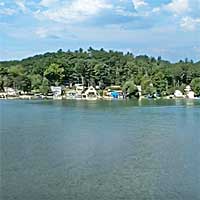 Torch Lake is an excellent destination for fishing. The lake is 19 miles long with 18,800 surface acres. and over 40 miles of shoreline. Known for its crystal clear water, the lake is renowned for its populations of smallmouth bass, largemouth bass, northern pike and yellow perch.
Torch Lake is an excellent destination for fishing. The lake is 19 miles long with 18,800 surface acres. and over 40 miles of shoreline. Known for its crystal clear water, the lake is renowned for its populations of smallmouth bass, largemouth bass, northern pike and yellow perch.
Primary fish species to catch
Click images for fishing tips and details about each species.
Today's Weather & Forecast
Fishing Boat Rentals
Click here for fishing boat rentals.
Public Boat Launch Ramps & Landings
Click here for boat ramps.
Fishing License
Click here for a Michigan Fishing License.
Map - Fishing & Access
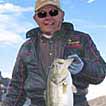 Rick Seaman is a fishing enthusiast with over five decades of fishing experience, a retired tournament fisherman, author of numerous published articles on fishing, and co-author of the book "Bass Fishing - It's not WHAT you throw, It's WHERE you throw it".
Rick Seaman is a fishing enthusiast with over five decades of fishing experience, a retired tournament fisherman, author of numerous published articles on fishing, and co-author of the book "Bass Fishing - It's not WHAT you throw, It's WHERE you throw it".
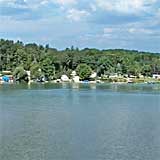 Contact Information
Contact Information
Dewitt Marine
6509 Crystal Springs Rd.
Bellaire, Michigan
231 377-6611
Fishing lakes in each state
102725
Torch Lake, Michigan Report
MICHIGAN


Fishing for smallmouth bass, lake trout, Atlantic salmon, muskie and northern pike in the northwest part of the lower peninsula, MI.


